From Zeroes to Heroes
by Steve Goldberg
The Batsford Book of Chess: From Beginner to Winner, by Sean Marsh, Batsford 2014, Algebraic Notation, Hardcover, 208pp. $22.95 (ChessCafe Price $17.21)
The original Batsford Book of Chess, penned by Robert Wade, appeared in 1974 with the title Playing Chess. Subsequent editions, with the name changed to The Batsford Book of Chess, were published in 1984 and in 1991.
These earlier versions were intended for newer players, as is the current edition. Author Sean Marsh notes his goals for this book:
- Using our quick start guides, to teach novices of all ages the basics – so they can begin to play chess in the shortest possible time.
- After a little practice, to encourage new players to return to the book and move on to more challenging work, such as the study of tactics, positional play and the principles of chess openings.
- To introduce a number of chess heroes and examples of their skillful play. Hopefully, these instructive games will whet the appetites of readers, who will then be inspired to look at other masterpieces and develop a lasting interest in the history and culture of chess.
- To encourage independent work by means of test yourself puzzles.
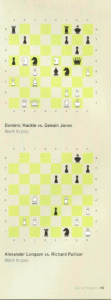
It is an eye-catching book, with diagrams in a variety of colors and clear fonts. I did find, however, that with the beige page background, some of the diagrams were easier on the eyes than others.
The table of contents provides a combination of both clarity and mystery regarding the information presented:
- Remembering Bob Wade
- Introduction
- The Basics
- Winning, Drawing and Losing
- Tactical Weapons
- Positional Play
- When Heroes Meet
- Human Factors
- Non-Human Factors
- Know Your Openings
- Classic Players and Games
- Solutions to Puzzles
- Bibliography
The book begins with a nice two-page tribute to the late Robert Wade. Following a brief introductory note, the following two chapters (“The Basics” and “Winning, Drawing and Losing”) introduce the reader to the moves of the pieces, the relative value of the pieces, and basic elements of how a game is won, drawn, or lost. A very brief explanation of chess notation is also included.
These chapters are good for a quick review for a newer player, but not really suitable for someone entirely new to chess. Piece movement and notation will likely remain mysteries to such a reader.
“Tactical Weapons” and “Positional Play” begin to introduce very basic tactical and strategic elements to the reader. There are two simple puzzle positions given in the “Tactical Weapons” chapter, but oddly, the solutions are not provided. Later in this chapter, however, there are sixteen additional problems for which solutions do appear at the end of the book.

Prominent players in chess history appear as “Heroes” at various junctures throughout the book, related to specific areas in which they excelled. For example, Mikhail Tal is presented as the “Hero of Tactical Play,” Tigran Petrosian is labeled the “Hero of Positional Play,” while Bobby Fischer is given the title of “Hero of the Spanish Game.” In each case, interesting games of the player in question are presented, with helpful annotations.
“When Heroes Meet” is an interesting chapter illustrating four well-annotated contests between Tal and Petrosian. “Human Factors” reviews issues such as routine blunders and time pressure problems, and how to try to avoid them. “Non-Human Factors” presents three Kasparov-computer duels, again with primarily textual annotations, as opposed to dense variation analysis.
The “Know Your Openings” chapter touches very briefly on a wide variety of openings, but a couple of the choices presented may raise a few eyebrows. Most of the more common openings appear, but the reader will also find such oddities as the St. George Defense (1.e4 a6), the Polish Defense (1.d4 b5) and Grob’s Opening (1.g4). In fairness, the author notes that these are not good moves.
It may just be a matter of taste, but I would have preferred fewer openings covered, if only to avoid overwhelming the reader with what may appear to be too many confusing options. I do like the latter portion of the chapter detailing several classic opening systems, with annotated games utilizing these openings.
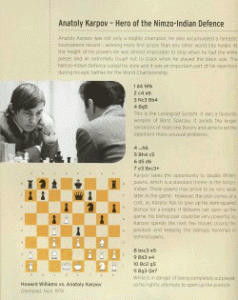
“Classic Players and Games” provides a listing of chess world champions, and presents a variety of annotated championship games throughout the years, right up to the 2013 Anand-Carlsen match.
Examining the author’s goals (provided at the beginning of this review), I would suggest that he has been successful with three of his four goals. While I would not recommend this book for the rank novice first trying to learn the game, it is perfectly suitable for the player who already knows how the pieces move and can read chess notation, but is pretty much lost otherwise.
The appropriately annotated games (and there are many of them) will help such a player understand some of the basics of what is going on in a given game, and the presentation of some of the greatest players should whet his or her appetite to learn more about the game by searching out additional annotated games by the great masters.
I might have added a fifth goal for The Batsford Book of Chess – to introduce the reader to a little of the excitement and mysterious allure of the game. I think this was also achieved.
My assessment of this product: ![]()
Order The Batsford Book of Chess
by Sean Marsh
© 2014 ChessEdu.org. All Rights Reserved.
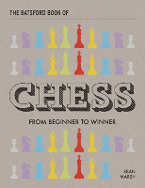
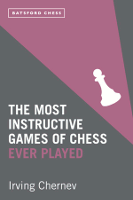
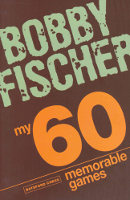
Leave a Reply